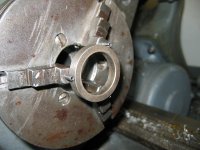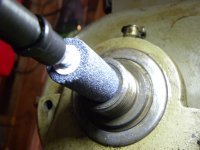Decided to start a new thread instead of continuing my older thread on Tool Post Grinder alignment.
This has been a very interesting exercise and I have learned a lot but I still have bellmouthed jaws.
[video]http://www.practicalmachinist.com/vb/general/how-align-tool-post-grinder-348245/[/video]
I have learned that the problem is not the tool post grinder alignment per se.
Even if the grinder is not aligned the leading edge of the grinding wheel will run in a straight line.
So why are my jaws bellmouthed @> 15 thou?
And how do I get them straightened out?
edwin dirnbeck in my previous thread advised me to not use the tool post grinder but to use a boring bar and carbide bit.
I tried that, interesting I have never used a boring bar on the lathe so I learned something even if it didn't work.
It seemed to reduce the bellmouthing but I still have a bit.
Thanks for all of your help and suggestions.
Ralph
This has been a very interesting exercise and I have learned a lot but I still have bellmouthed jaws.
[video]http://www.practicalmachinist.com/vb/general/how-align-tool-post-grinder-348245/[/video]
I have learned that the problem is not the tool post grinder alignment per se.
So why are my jaws bellmouthed @> 15 thou?
And how do I get them straightened out?
edwin dirnbeck in my previous thread advised me to not use the tool post grinder but to use a boring bar and carbide bit.
I tried that, interesting I have never used a boring bar on the lathe so I learned something even if it didn't work.
It seemed to reduce the bellmouthing but I still have a bit.
Thanks for all of your help and suggestions.
Ralph






